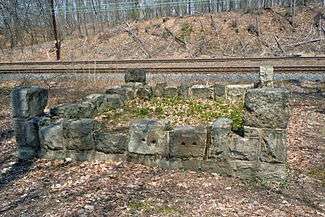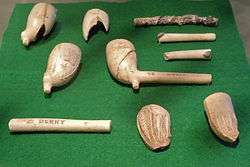Duffy's Cut
Coordinates: 40°02′0.6″N 75°31′45.84″W / 40.033500°N 75.5294000°W



Duffy's Cut is the name given to a stretch of railroad tracks about 30 miles west of Philadelphia, United States, originally built for the Philadelphia and Columbia Railroad in the summer and fall of 1832. The line later became part of the Pennsylvania Railroad's Main Line. Railroad contractor Philip Duffy hired 57 Irish immigrants to lay this line through the area's densely wooded hills and ravines. The workers came to Philadelphia from the Ulster counties of Donegal, Tyrone and Derry to work in Pennsylvania's nascent railroad industry. Less than two months after their arrival, all 57 are believed to have died during the second cholera pandemic. While most died of the disease, forensic evidence suggests that some may have been murdered, perhaps due to fear of contagion,[2] as the pandemic spanned several continents and many years.[3]
The site is located near Malvern, Pennsylvania in East Whiteland Township[4] near the intersection of King Road and Sugartown Road, where a Pennsylvania state historical marker has been placed.[5]
History
Prejudice against immigrants generally and Irish Catholics specifically contributed to the denial of care to these immigrant workers, who were often viewed by the owners and managers of railroad and coal mining companies as expendable components, and by Native Americans as unwholesome and even dangerous. Philip Duffy's blacksmith buried the first three to perish in individual graves, but when it became clear that all would die he buried the rest of the dead workers in a shallow ditch along the railroad’s right of way without ceremony or funeral.[5] No death certificates were ever filed for these individuals. Asiatic Cholera usually causes 40-60% casualties within a single population. In this case, all of the workers are believed to have died, leading to the theory that some may have been killed.[5]
Official record of the deaths at Duffy’s Cut remained locked in the vaults of the Pennsylvania Railroad (PRR) until Joseph Tripican, a secretary to a former PRR president, removed them after the company’s bankruptcy in 1970. In the 1990s, one of Tripican’s grandsons, Reverend Dr. Frank Watson discovered the papers in a file and began to research the history with his brother Dr. William Watson, Professor of History, and adjunct professors Earl Schandelmeier and John Ahtes of Immaculata University.[5]
On June 18, 2004, a Pennsylvania state historical marker was dedicated near the site. The text of the marker reads, "Nearby is the mass grave of fifty-seven Irish immigrant workers who died in August, 1832, of cholera. They had recently arrived in the United States and were employed by a construction contractor, named Duffy, for the Philadelphia and Columbia Railroad. Prejudice against Irish Catholics contributed to the denial of care to the workers. Their illness and death typified the hazards faced by many 19th century immigrant industrial workers."
In August 2004, the site began undergoing archaeological excavation by a research team headed by Dr. William Watson from Immaculata University, Rev. Dr. Frank Watson, Earl Schandelmeier, and John Ahtes. The Duffy's Cut Project team consisted of four primary members, William Watson, Frank Watson, John Ahtes (who died in 2010) and Earl Schandelmeier at Immaculata University. On March 20, 2009, the first human bones were unearthed, consisting of two skulls, six teeth and eighty other bones. The researchers announced their discovery on March 24, 2009.[6]
In August 2009, "Finding Dulcinea" reported that the two earliest skulls found both show evidence of blunt-force trauma inflicted peri-mortem, suggesting the possibility that they were murdered.[7] More recent research of the site suggests that a mass murder may have taken place against the Irish workers[8] by local vigilantes fearful that cholera would spread. Analysis of the bones has indicated the possibility that some of the men were killed by projectiles.[9][10][11]
On March 9, 2012, the remains of five men and one woman from those who died at Duffy's Cut Shanty Town were laid to rest in a church burial at West Laurel Hill Cemetery in Bala Cynwyd, Pennsylvania.[12] The men and woman were unearthed by researchers from Immaculata University at the location of the Shanty Town near an Amtrak railroad line in Pennsylvania.[13] A sixth body was recovered and identified as John Ruddy from Inishowen, County Donegal; his remains were returned to Ireland for reburial there.[14] in 2013[15] The remains of Catherine Burns of County Tyrone who died in Duffy's Cut in 1832 were reburied in Ireland in 2015[15] Excavation of the deep burial site was halted when Amtrak, which owns the land, would not issue permits for additional digging because of the site's proximity to the railroad tracks.[16]
In popular culture
Television
- Tile Films of Dublin, Ireland produced a documentary on the story for broadcast on the Irish State Broadcaster RTÉ., then went on to produce a follow-up with WNET, "Death on the Railroad" as an episode of the PBS series Secrets of the Dead (season 12, episode 2) first aired May 8, 2013.[1] and RTÉ. In this episode, the claim was made that modern forensic science determined that the 57 Irish railroad workers did not perish as the result of cholera, but instead were murdered. No conclusion was drawn as to motive, although many theories were offered.
- Greenwood Publishing Group published The Ghosts of Duffy's Cut in July 2006.[2]
| "Duffy's Cut" | |
|---|---|
| Song by Christy Moore and Wally Page (writer) | |
| Published | 2009 |
| Writer(s) | Wally Page |
| Language | English |
Music
- Irish musician Christy Moore released a song, written by Wally Page, called "Duffy's Cut" (2009), whose subject matter is the death of the workers on the railway.[2]
- In March 2011, Celtic Punk band The Dropkick Murphys released a song called "The Hardest Mile", which also deals with the newly discovered evidence that some of the men may have been murdered rather than having died of cholera.
References
Notes
- 1 2 "Death on the Railroad". Secrets of the Dead. PBS. Retrieved May 9, 2013.
- 1 2 3 Watson, William E.; Watson, J. Francis; Schandelmeier, Earl H. & Ahtes, John H. (2006). The Ghosts of Duffy's Cut: The Irish who Died Building America's Most Dangerous Stretch of Railroad. Connecticut: Greenwood Publishing Group. ISBN 0-275-98727-2.
- ↑ Crimmins, Peter (2009-03-24). "Irish Laborers Buried Under Suburban Railroads". Weekend Edition. WHYY/NPR. Retrieved 2009-03-24.
- ↑ Miller, Jennifer (2009-03-24). "Bones may reveal Pa. grave of Irish immigrants in Chesco". The (Delaware County) Daily Times. Retrieved 2009-03-24.
- 1 2 3 4 Barry, Dan (March 25, 2013) "With Shovels and Science, a Grim Story Is Told" The New York Times
- ↑ McClements, Freya (2009-03-24). "Secrets of mass grave revealed". BBC News. Retrieved 2009-03-24.
- ↑ Finding Dulcinea
- ↑ Valentino, Claudia, ed. (November–December 2010). "World Roundup: Pennsylvania". Archaeology. Long Island City, New York. 63 (3): 14.
- ↑ Staff (May 23, 2010). "Fates Of Irish Workers Sealed In Mass Grave". All Things Considered. Retrieved 2010-08-24.
- ↑ Matheson, Kathy (16 August 2010). "Old Irish bones may yield murderous secrets in Pa.". AP. Archived from the original (Yahoo News article online) on August 20, 2010. Retrieved 16 August 2010.
- ↑ http://www.aolnews.com/nation/article/duffys-cut-mass-grave-in-pennsylvania-did-irish-immigrants-die-of-cholera-or-were-they-murdered/19606498?icid=main|netscape|dl1|sec1_lnk3|166114
- ↑ http://www.westlaurelhillcemetery.com/373356/2012/02/19/duffys-cut-memorial-service--burial.html
- ↑ http://duffyscut.immaculata.edu
- ↑ http://www.irishcentral.com/news/-Five-murdered-Irish-emigrants-will-be-reburied-in-a-new-grave-today-142041103.html
- 1 2 BBC July 19, 2015
- ↑ http://www.irishcentral.com/roots/Duffys-Cut-dig-ends-as-Amtrak-refuses-mass-grave-excavation-132908668.html
External links
| Wikimedia Commons has media related to Duffy's Cut. |
- The Duffy's Cut (Archaeological) Project, an Immaculata University website
- Marker Details: Duffy's Cut Mass Grave, a Pennsylvania State Historical Marker from the Pennsylvania Historical and Museum Commission
- Grandfather's ghost story leads to mysterious mass grave, an August 2010 CNN article with video about the mass grave at Duffy's Cut]
- Ireland's Forgotten Sons Recovered Two Centuries Later, Abigail Tucker, Smithsonian Magazine
- Murder in the Time of Cholera, Jonathan Valania, Philadelphia Weekly.
- Bones Beneath the Tracks, Samuel Hughes, Penn Gazette.
- Peter Loftus The Mystery of Duffy's Cut, Wall Street Journal, April 14, 2011
- Fate of Irish Workers Sealed in Mass Grave, interview on NPR's "All Things Considered," with Guy Raz, May 23, 2010
- Forgotten Irish Laborers Finally Laid To Rest, NPR's "Weekend Edition," by Peter Crimmins, March 11, 2012
- Duffy's Cut Mass grave at Find A grave
- HMdb - Duffy's Cut Marker - Historical Marker database
- Irish Immigrants' Mystery Honored in Burial, "Irish Immigrants' Mystery Honored in Burial," Wall Street Journal, Peter Loftus, March 9, 2012
- With Shovels and Science, a Grim Story Can Be Told, New York Times, Dan Barry, 24 March 2013
- Death on the Railroad Documentary produced by the PBS Series Secrets of the Dead
- Duffy's Cut Clonmany Genealogy